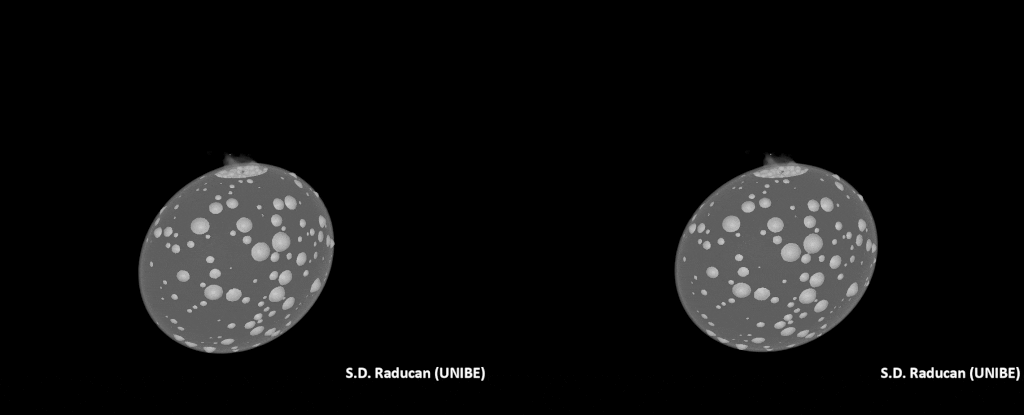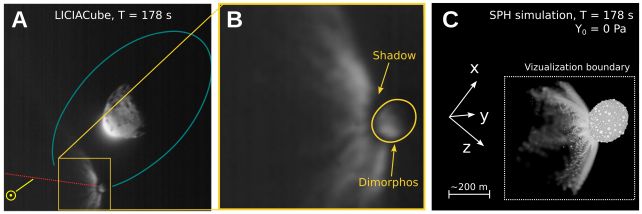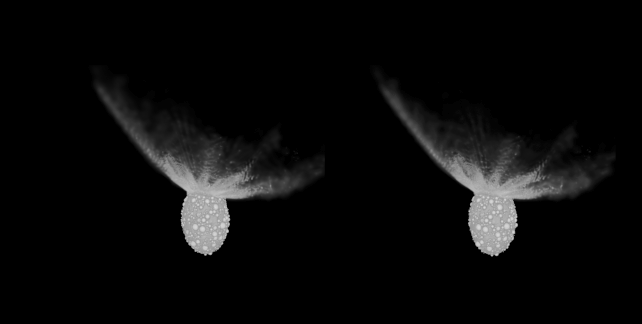ARTICLE AD
 A stereoscopic movie generated from the team's simulations showing the first 30 minutes after the impact. (S.D. Raducan, UNIBE)
A stereoscopic movie generated from the team's simulations showing the first 30 minutes after the impact. (S.D. Raducan, UNIBE)
Smacking a spacecraft into an asteroid may have had some interesting side effects.
According to an analysis of a collision between NASA's DART probe and the asteroid Dimorphos back in September 2022, the tiny asteroid's shape could have changed significantly as a direct result of the impact.
This offers some clues about how the asteroid formed in the first place, while also suggesting the upcoming mission to investigate Dimorphos will find not an impact crater, but a neatly reformed pile of space rock.
The DART mission – Double Asteroid Redirection Test – was one of planetary safety. Scientists wanted to see if they could divert the course of an asteroid by ramming it with a spacecraft. Dimorphos was the chosen target – a small asteroid in a mutual orbit with a larger binary companion called Didymos. Because the orbital period of the binary object was well known, any changes in the timing of this period would mean that the mission was successful.
And a success it was: the impact had a much greater effect on the timing of the period than scientists expected. But the DART mission was the first time humanity had ever tried such a thing; we didn't know if there would be ongoing effects to observe, what those effects might be, what they could mean for asteroid redirection, and what, if anything, they would tell us about Dimorphos.
Obviously, scientists have been monitoring the space rock for changes. But a team led by planetary scientist Sabina Raducan of the University of Bern in Switzerland took a different approach. They took a simulated Dimorphos and a simulated DART spacecraft, and tried to replicate the observed effects of the impact.
 A comparison of the observation of the DART impact (left, center) and the simulation (right). (Raducan et al., Nature Astronomy, 2024)
A comparison of the observation of the DART impact (left, center) and the simulation (right). (Raducan et al., Nature Astronomy, 2024)That includes the transferral of momentum from the spacecraft to the asteroid, the amount of material that erupted from Dimorphos, and the shape that material formed as it spewed into space, known as the ejecta cone.
To do this, they needed to tweak unknown variables: the composition and density of Dimorphos.
Not all asteroids are built alike. Some are more dense, such as chunks of planets arrested in their development by large impacts and broken up into smaller fragments. And some are what are known as "rubble piles", which is pretty much what it sounds like: looser agglomerations of dust and pebbles that have come together, but would be more susceptible to coming apart under gravitational stress, for example.
We already knew that both Didymos and Dimorphos fall into the rubble pile category. But the DART impact can tell us exactly what Dimorphos is made of.
Raducan and her colleagues were able to produce simulations consistent with the observed result of the DART project. And, in these simulations, the asteroid is held together so loosely that DART didn't leave a scar on the surface; instead, the spacecraft caused global deformation and resurfacing.
For this to occur, the asteroid needs to be a very weak rubble pile; its cohesive strength, the team's calculations suggest, is less than a few pascals. This is very similar to asteroids Ryugu and Bennu, both of which have been visited by human spacecraft for data and sample collection.
The simulations also suggest that the density of Dimorphos is very low, around 2.4 grams per cubic centimeter. That's slightly denser than Ryugu and Bennu, which sit around 1.28 and 1.26 grams per cubic centimeter, respectively. The density of Earth, for context, is 5.51 grams per cubic centimeter.
The boulder density of the simulated Dimorphos was consistent with the density obtained from DART observations.
 A stereoscopic movie generated from the simulations showing Dimorphos at approximately 178 seconds post-impact. (S.D. Raducan/C. Manzoni/B.H. May)
A stereoscopic movie generated from the simulations showing Dimorphos at approximately 178 seconds post-impact. (S.D. Raducan/C. Manzoni/B.H. May)These findings suggest that Dimorphos may be Didymos' asteroid baby. Didymos is also a rubble pile, and we know that rubble piles often shed debris as they spin, thanks to centrifugal force. Some of this shed debris remains in orbit with Didymos, according to this model of Dimorphos' formation; over time, it clumped together to become the loose rubble pile we walloped with a spaceship.
We don't know if they're right, not yet. But we will. Later this year, the European Space Agency is launching the Hera mission to study Didymos and Dimorphos. If what Hera finds is consistent with the team's simulations, we'll know a lot more about Dimorphos than we did.
And this has implications, not just for our understanding of the ongoing evolution of the binary, but asteroids, asteroid binaries, and how we plan and execute any upcoming asteroid redirection missions.
"Since the DART spacecraft probably caused global deformation of Dimorphos, we can infer that similarly formed asteroid moons are easily reshaped and their surfaces are relatively young," the researchers write in their paper.
"Overall, the findings of this study provide valuable information for understanding the formation and characteristics of binary asteroids and will inform future exploration and asteroid deflection efforts."
The research has been published in Nature Astronomy.

 11 months ago
74
11 months ago
74 

